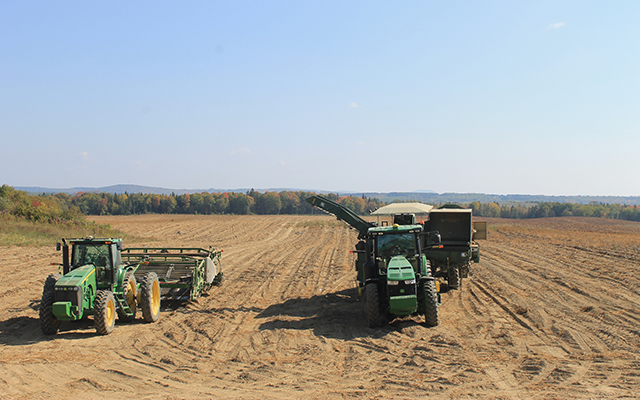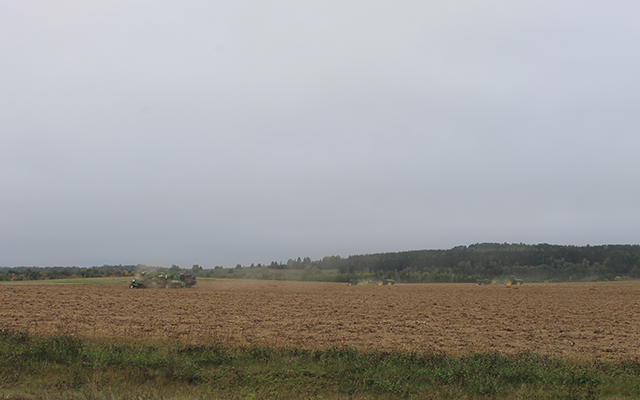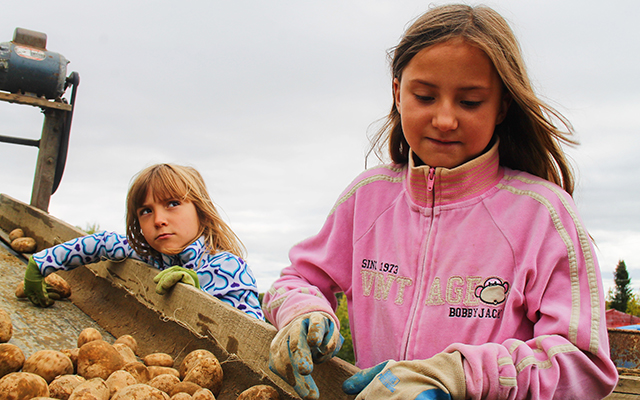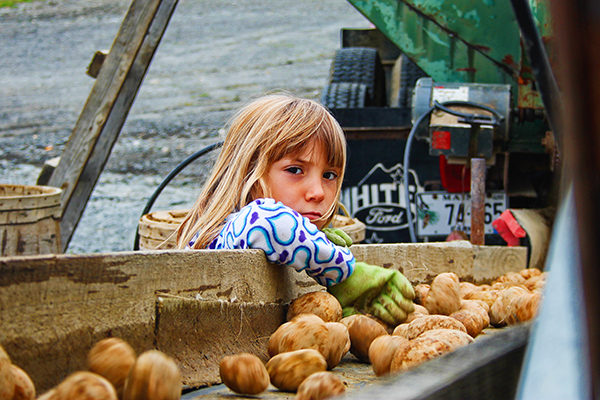
In a rare September with days that felt like August, some potato farms paused their harvest work on the hottest of days.
“It’s been a bit slow with the heat,” said Darrell McCrum of Mars Hill-based Super Spuds on Wednesday, Sept. 27.
- Crews with County Super Spuds digging and harvesting potatoes at a field on Route 1A in Fort Fairfield Wednesday, after two days of putting off field harvesting due to 80-degree plus temperatures. (Anthony Brino | BDN)
McCrum, who oversees more than 3,000 acres of the family business’ potato production in central Aroostook County, said they decided not to harvest on Monday and Tuesday when temperatures were reaching into the high 80s.
“The heat was just too extreme,” McCrum said.
Coming out of the soil, potatoes were recorded with internal temperatures in the high 60s — whereas the ideal range for spuds going into storage is between 50 degrees and 60 degrees, McCrum said. If the potatoes are too warm when stored, they can be at risk for rotting and other diseases throughout the winter.
- Sisters Abby, left, and Lydia Pelletier sort through freshly harvested potatoes, Thursday morning at their grandfather’s farm in Fort Kent. Dave and Bev Pelletier grow about 20 acres of Russets each year. (Don Eno)
The same was true at Bartlett Farms in Littleton, where longtime farmers Bob Bartlett and his son David, had to cease harvesting at noon on the hotter days of this past week. Bartlett Farms specializes in for seed potatoes for use in growing both chip and table stock.
Thursday, there was a different problem, as the heavy rains that pounded the area Wednesday evening made the ground too wet for digging, at least for the Bartletts.
“We had such a dry summer that the ground is extremely hard,” said Laurie Bartlett, David’s wife. “We have had crazy amounts of dirt clods because it just won’t break up. The rain we got wouldn’t immediately soak in, so the ground would be slimy, (which is) not easy going for the tractors.”
- Abby Pelletier glances up from her work, Thursday morning. She was helping her grandparents, Dave and Bev Pelletier sort and load potatoes at their farm in Fort Kent. (Don Eno)
September could end up as one of the warmest Septembers on record in northern Maine, with multiple records for late-season high temperatures now broken.
Caribou broke its high temperature records on Sunday, Sept. 24, with a high of 85, and on Monday and Tuesday with highs of 88. “It was the warmest temperature ever observed so late in the season,” according to the National Weather Service in Caribou.
With Wednesday being noticeably cooler than the day before — reaching into mid 70s — farm crews that took a break from the heat have been back at work.
McCrum estimated that County Super Spuds has harvested 10 percent of its crop and may finish later than planned because of the break.
“Our goal is to finish by October 15. I can see that going to October 20,” McCrum said.
The September heat wave came on the heels of another relatively dry summer with below average precipitation, which can bring benefits and drawbacks to different crops.
“The crop is lighter in yield,” McCrum said, referring to the impact of the dry summer on his crop. “I’ll say slightly below average.”
On the flip side, “the quality of crop is really nice,” he said. “We’ve got a good disease-free crop in the ground.”
About one-third of County Super Spuds’ potato fields have irrigation systems. “In those fields, the yield is phenomenal,” McCrum said.
Most Maine potato farms do not have irrigation systems, however, and depend on rainfall.

Crews work hard on Sept. 21 harvesting potatoes on Flewelling Farms in Easton. The farm belongs to Jerry and Bruce Flewelling.
(Courtesy of David Shaw)
Tim Hobbs, director of development and grower relations at the Maine Potato Board, said that many farms are reporting early harvest results with good quality but yields of “just under average.”
About 47,000 acres of potatoes were planted in Maine last year and an estimated 48,000 were planted this year, according to the United States Department of Agriculture’s statistics. Most of that acreage is located in Aroostook County, with several thousand acres as well in the Androscoggin Valley and central Maine.
More than two-thirds of the Maine potato crop is grown for McCain Foods and other processing companies, while about 20 percent is devoted to high-value seed potatoes and about 10 percent to fresh cooking potatoes.

Crews work hard on Sept. 21 harvesting potatoes on Flewelling Farms in Easton. The farm belongs to Jerry and Bruce Flewelling.
(Courtesy of David Shaw)
In 2015 and 2016, Maine potato growers saw back-to-back bumper crops with yields exceeding averages in the past decade.
Last year, the average yield was 325 hundredweight per acre (the equivalent of 18.2 tons), an increase over the 320 hundredweight per acre average in 2015, according to the USDA statistics.
The value of all potatoes sold in Maine also increased 11 percent in 2016 to $159.2 million, according to the USDA.











